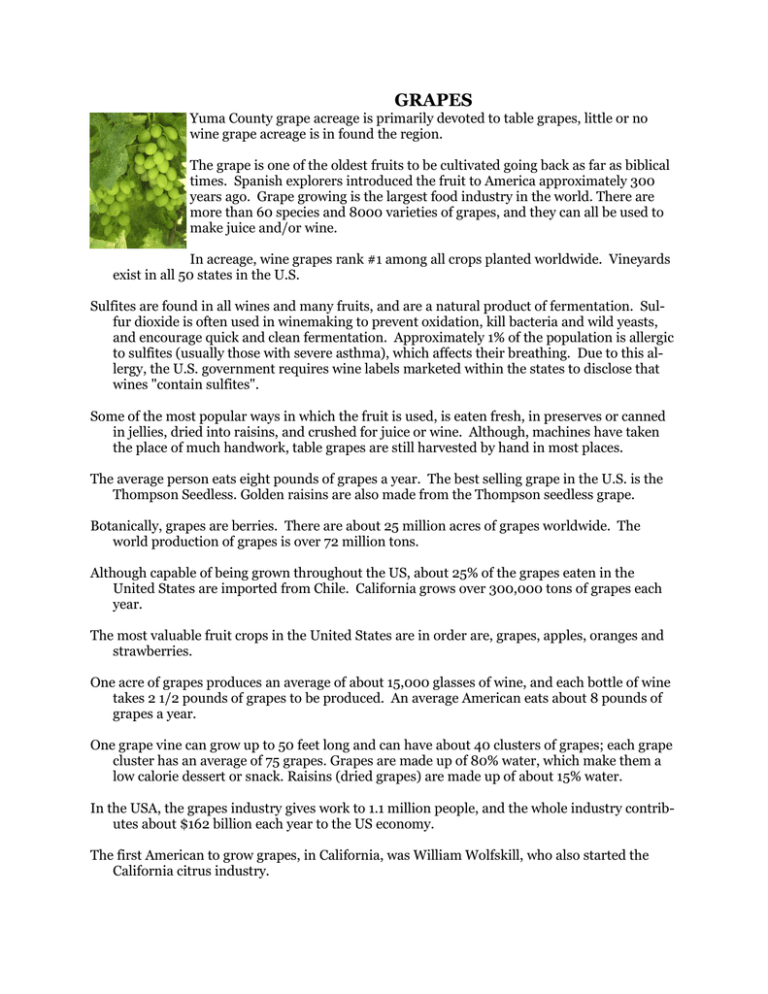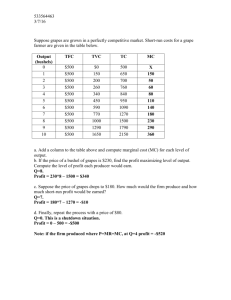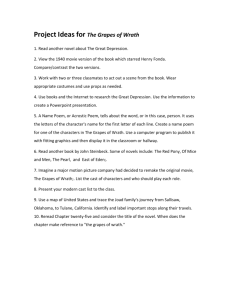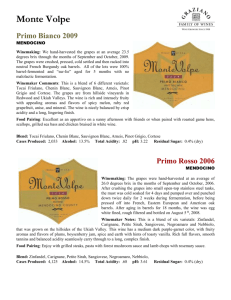GRAPES
advertisement

GRAPES Yuma County grape acreage is primarily devoted to table grapes, little or no wine grape acreage is in found the region. The grape is one of the oldest fruits to be cultivated going back as far as biblical times. Spanish explorers introduced the fruit to America approximately 300 years ago. Grape growing is the largest food industry in the world. There are more than 60 species and 8000 varieties of grapes, and they can all be used to make juice and/or wine. In acreage, wine grapes rank #1 among all crops planted worldwide. Vineyards exist in all 50 states in the U.S. Sulfites are found in all wines and many fruits, and are a natural product of fermentation. Sulfur dioxide is often used in winemaking to prevent oxidation, kill bacteria and wild yeasts, and encourage quick and clean fermentation. Approximately 1% of the population is allergic to sulfites (usually those with severe asthma), which affects their breathing. Due to this allergy, the U.S. government requires wine labels marketed within the states to disclose that wines "contain sulfites". Some of the most popular ways in which the fruit is used, is eaten fresh, in preserves or canned in jellies, dried into raisins, and crushed for juice or wine. Although, machines have taken the place of much handwork, table grapes are still harvested by hand in most places. The average person eats eight pounds of grapes a year. The best selling grape in the U.S. is the Thompson Seedless. Golden raisins are also made from the Thompson seedless grape. Botanically, grapes are berries. There are about 25 million acres of grapes worldwide. The world production of grapes is over 72 million tons. Although capable of being grown throughout the US, about 25% of the grapes eaten in the United States are imported from Chile. California grows over 300,000 tons of grapes each year. The most valuable fruit crops in the United States are in order are, grapes, apples, oranges and strawberries. One acre of grapes produces an average of about 15,000 glasses of wine, and each bottle of wine takes 2 1/2 pounds of grapes to be produced. An average American eats about 8 pounds of grapes a year. One grape vine can grow up to 50 feet long and can have about 40 clusters of grapes; each grape cluster has an average of 75 grapes. Grapes are made up of 80% water, which make them a low calorie dessert or snack. Raisins (dried grapes) are made up of about 15% water. In the USA, the grapes industry gives work to 1.1 million people, and the whole industry contributes about $162 billion each year to the US economy. The first American to grow grapes, in California, was William Wolfskill, who also started the California citrus industry. Red wines contain more antioxidants than white wines. Concord grapes are named after Concord, Massachusetts. There are more than 60 species and 8000 varieties of grapes all over the world. Some common varieties of grapes are blue, black, green, red, golden, blue-black, white and purple. It takes about 2½ pounds of grapes to produce a bottle of wine. One acre of grapes can produce an average of about 15,000 glasses of wine. Grapes consist of about 80% of water, which make them a low-calorie snack or dessert. Raisins or dried grapes consist of about 15% of water. Grapes contain flavonoids that give vibrant purple color to grapes, red wine and grape juice. Fresh grapes can be stored in the refrigerator for about 2-3 days, when kept in a plastic bag or a covered container. Grapes are known for having a high nutritional value. Grapes are rich in vitamin C and vitamin K. They contain low levels of cholesterol, fat and sodium. Grapes are known for containing proteins, carbohydrates, dietary fibers, and vitamin and minerals. They contain high amounts of caffeic acid, which is a strong cancer-fighting substance. Grapes contain flavonoids, which are powerful antioxidants. A study led by Dr. Randall Holcombe found that resveratrol, a substance found in grapes, has been linked to reducing colon cancer. Grapes are extremely good for your health; they can help to cure problems such as Alzheimer’s disease, asthma, constipation, heart diseases, indigestion, kidney diseases and migraine. Eating grapes will also minimize the risk of having a heart attack. Some of the most common ways we use grapes is to eat them fresh, preserve them in cans, dry them into raisins, and crush them for wine or juice. The average person eats eight pounds of grapes each year, although I wouldn't eat all that at once, eating too many grapes can give a laxative effect. Numerous studies have shown the health benefits of red wine, but drinking grape juice provides most of the benefits, without the risk that comes with alcohol consumption. For enhanced taste and flavor, serve grapes slightly chilled. If you're planning on squeezing your grape juice by yourself, use a glass bottle and fill it completely; this prevents oxidation and damage to the juice. The longer the juice is stored, the more nutrients are lost; this is why it is recommended that you drink your grape juice as soon as possible. Kurt Nolte is an area agriculture agent with the Yuma County Cooperative Extension. He can be reached at 928-726-3904.





